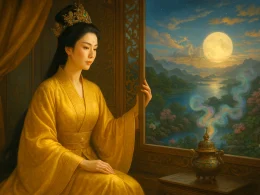The land of mulberry is in the boundless sea;
Your home's farther east to the land of mulberry.
Who would arrive with you at the land of your dreams?
A sail unfurled in wind, a boat steeped in moonbeams.
Original Poem
「送日本国僧敬龙归」
韦庄
扶桑已在渺茫中,家在扶桑东更东。
此去与师谁共到,一船明月一帆风。
Interpretation
This poem was composed during the turbulent late Tang period when domestic upheavals had suspended Japan's official diplomatic missions to China. Japanese monks and scholars thereafter traveled between the two nations via merchant ships. The poet Wei Zhuang, having befriended the Japanese monk Keiryu during his studies in Guozhou, penned this work upon Keiryu's return to Japan—expressing both heartfelt farewell and sincere blessings.
First Couplet: "扶桑已在渺茫中,家在扶桑东更东。"
Fú sāng yǐ zài miǎo máng zhōng, Jiā zài fú sāng dōng gèng dōng.
Fusang already fades in boundless haze;
Your homeland lies east of the east beyond its rays.
The poet begins with "Fusang"—a term simultaneously denoting Japan and alluding to the mythical Fusang tree from Chinese lore where the sun was said to rise. The first line establishes Japan's distant horizon, while the second intensifies this remoteness through layered directional repetition ("east of east"), casting an aura of mystery over the journey.
Second Couplet: "此去与师谁共到?一船明月一帆风。"
Cǐ qù yǔ shī shuí gòng dào, Yī chuán míng yuè yī fān fēng.
Who shall accompany your voyage true?
Just moonlit hull and wind-filled sail—your crew.
The rhetorical question transitions into a sublime response: moonlight and favorable winds personified as celestial companions. The "moon" symbolizes the monk's enlightened mind, while the "fair wind" implies divine protection—a dual blessing for both safe passage and spiritual attainment.
Holistic Appreciation
The poem "Farewell to a Japanese Monk" conveys the poet's blessings and parting sentiments to his friend through concise language. It expresses not only lamentations about the distant journey home but also transmits the poet's sincere wishes through depictions of natural scenery. The repetition of "Fusang" and "east of east" emphasizes the remoteness and mystique of the journey home, while the personification of "bright moon" and "sail-wind" presents a beautiful vision of smooth sailing. The poem is filled with emotion and poetic charm, skillfully blending blessings with imagery to form a magnificent picture of a moonlit sea voyage, showcasing the poet's delicate and profound state of mind.
Artistic Merits
- Delicate Emotional Expression: Although the poet does not directly express sadness, he conveys his blessings and emotions for his friend's return through subtle descriptions. The line "Fusang already fades in boundless haze" not only depicts the distant journey but also implies concern and anticipation for his friend.
- Profoundly Meaningful Metaphors: The poet cleverly uses the term "Fusang," drawing on the ancient mythological Fusang tree to vividly represent Japan while also hinting at the remoteness and inaccessibility of this mysterious eastern land.
- Integration of Scene and Emotion: The poet expresses his heartfelt wishes through natural imagery such as the "bright moon" and "sail-wind." This ingenious combination not only enhances the visual appeal of the poem but also makes the emotional expression more natural and fluid.
Insights
This poem teaches us that when facing farewells and long journeys, we should not only express blessings but also convey deep emotions and good wishes through metaphors of natural scenery and meaningful expressions. The poet skillfully leverages the external world's natural imagery to make emotions more genuine and layered. This writing approach reminds us that when expressing emotions, we can draw on the surrounding scenery to let inner feelings and external beauty reflect each other, thereby enhancing the power and expressiveness of emotions.
Poem translator
Xu Yuanchong (许渊冲)
About the Poet
Wei Zhuang (韦庄), circa 836 - 910 A.D., a native of Xi'an in the southeast of Shaanxi Province, was a scholar and a minister of the Ministry of Revenue. There is a collection of “Raccoon Flower Collections” in circulation.












